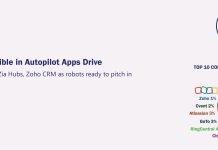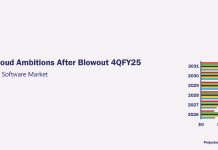As Oracle makes its way to transform itself into a Cloud-first vendor, the database kingpin provides proof points that it can win across the three product categories – Platform(PaaS), Infrastructure(IaaS) and Software as a Service(SaaS) delivery.
Thirteen months after its announcement to buy NetSuite for $9.3 billion, Oracle is closing in on its biggest competitors in SaaS delivery. According to our annual survey of more than 1,000 leading Cloud Computing vendors, Oracle posted the fastest growth among the top five SaaS vendors in 2016, as shown in Exhibit 1.
The results of the 13 Top Cloud Computing vendors and their performance across the three product categories and their market sizes, forecast assumptions and our taxonomy can be found in the accompanying report.
Exhibit 1 – Annual Growth Rates of Top 5 SaaS Vendors By Cloud Revenues, $M
| Top 5 SaaS Vendors | 2015 | 2016 | 2015-2016 Growth, % |
|---|---|---|---|
| Oracle | 1837 | 3211 | 75% |
| Salesforce | 5171 | 8182 | 58% |
| Microsoft | 2455 | 3415 | 39% |
| SAP | 2568 | 3532 | 38% |
| Adobe | 1417 | 1775 | 25% |
Source: Apps Run The World 2017
In the PaaS product category, Oracle, fueled by massive adoptions of its Data As A Service and 12c Cloud Database offerings, has performed even better besting Amazon by tripling its annual recurring revenues, as shown in Exhibit 2.
Exhibit 2 – Annual Growth Rates of Top 5 PaaS Vendors By Cloud Revenues, $M
| Top 5 PaaS Vendors | 2015 | 2016 | 2015-2016 Growth, % |
|---|---|---|---|
| Oracle | 206 | 629 | 205% |
| Amazon | 350 | 990 | 183% |
| Microsoft | 109 | 200 | 83% |
| Salesforce | 1137 | 1547 | 36% |
| SAP | 270 | 353 | 31% |
Source: Apps Run The World, 2017
In the IaaS product category, Oracle has trailed the pack with a 13% growth rate in 2016, as shown in Exhibit 3.
Exhibit 3 – Annual Growth Rates of Top 5 IaaS Vendors By Cloud Revenues, $M
| Top 6 IaaS Vendors | 2015 | 2016 | 2015-2016 Growth, % |
|---|---|---|---|
| Alibaba | 403 | 900 | 123% |
| Microsoft | 3260 | 6702 | 106% |
| IBM | 3734 | 5937 | 59% |
| Amazon | 7530 | 9900 | 31% |
| 1176 | 1371 | 17% | |
| Oracle | 646 | 732 | 13% |
Source: Apps Run The World 2017
Oracle SaaS Soars Across Apps
After years of product rewrites and enhancements, Oracle’s Cloud-first strategy is delivering on its promises based on its steep growth in SaaS and PaaS product categories largely as a result of cumulative effects of both organic and incremental gains from massive customer adoptions and recent purchases.
During a number of recent gatherings between Oracle executives and industry analysts, the vendor has reiterated the fact that it has completely rewritten its entire applications portfolio in order to ensure they outperform their peers in the Cloud. Thomas Kurian, president of product development of Oracle, said it has taken the vendor 11 years to create and perfect some of these products spanning some 400 modules.
Earlier this month, Oracle announced Cloud Applications Release 13, which covers hundreds of new features across Oracle Supply Chain Management (SCM) Cloud, Oracle Customer Experience (CX) Cloud Suite, Oracle Enterprise Resource Planning (ERP) Cloud and Oracle Human Capital Management (HCM) Cloud.
Mark Hurd, CEO of Oracle, said combining new Cloud features with their existing on-premise products like Oracle Database is what makes companies like AT&T more competitive and efficient than ever. AT&T is expected to move 10,000 Oracle databases to the Cloud, while making use of new Oracle applications including Oracle Field Service Cloud to improve the scheduling and dispatching of the telco’s army of 70,000 field technicians.
Another customer benefiting from Oracle’s beefed-up Cloud offerings is Twitter, which has seen increased business from advertisers by supplementing consumer insights from Oracle Data Cloud with Twitter traffic to craft more effective marketing campaigns for brands like Dr. Pepper and Planters Peanuts, said Rob Pietsch, senior director of sales and general manager at Twitter.
With thousands of developers working on optimizing its Cloud applications, Oracle Senior Vice President Rondy Ng said as much as 40% of such resources is dedicated to meeting new enhancement requests directly from customers. Ng said the result is not just better apps for the Cloud, but also the most relevant for a specific user group, adding that Cloud-based E-Business Suite, which is part of the vendor’s Oracle ERP Cloud, offers the most advanced localization capabilities for users in any region it sells into.
The upshot of such user-led innovations – customers are more willing to standardize on Oracle applications like ERP and HCM on a large scale that could cover tens of thousands users, resulting in substantially more recurring revenues for the vendor.
During its earnings call in June, Oracle disclosed that it has nearly 14,000 active SaaS customers. Our estimates show that half of them are running ERP, HCM or both, contributing to larger deals and more extensive use of Oracle Cloud applications across its multinational clients.
Fast Pass With Oracle PaaS
Despite its SaaS momentum, CTO Larry Ellison said during the earnings call that Oracle’s PaaS and IaaS could become even bigger than its Cloud applications business because of the massive database migration to the Cloud currently underway(as seen in the AT&T example) and the synergy between Oracle Cloud and the technology Red Stack that its customers will eventually embrace.
The last quarter was the first time that its PaaS business was broken out after the vendor reclassified it along with IaaS, a move that makes it possible to identify Oracle’s growth in each product category. Since the release of Oracle 12c in 2013, it has been a guessing game for most observers on the pace of its adoptions. Unlocking the growth history of Oracle PaaS suggests that the 12c, which is believed to have played a major role behind the tripling of Oracle PaaS revenues in fiscal 2017, has finally reached the critical mass of early adopters as well as those that are committed to migrate their onpremise database workloads to the Cloud.
It could be years before Oracle’s PaaS business matches its on-premise database sales, which remain to be many times bigger than what Oracle can recognize the recurring revenues of its Cloud database products in a given quarter.
Still, the accelerated migration of some of its biggest onpremise database customers gives credence to the specter that PaaS may well be the center of gravity for Oracle in the next decade, the same sway that Oracle 11g and its predecessors have enjoyed shepherding the company for much of its history.
Oracle IaaS is the Wild Card
Oracle IaaS has been growing steadily over the past few years, but that’s about to change. Inside a 30-story building in downtown Seattle, Oracle has been staffing up by hiring hundreds of developers in recent quarters to help strengthen its infrastructure business, a decision that takes aim directly at its cross-town rivals Amazon and Microsoft.
Many of these new hires came from Amazon, who felt that the pace of innovation has slackened at the giant online seller after years of toiling away at the AWS Blackfoot building essentially retrofitting something that was designed to handle its own eCommerce workload. That was the reasoning that Oracle has impressed upon visitors to the Seattle outpost.
At Oracle, these newly-hired engineers harness the entire Oracle stack including identity and access management, storage, objects, kernel, operating system, DNS(via the Dyn acquisition in 2017), not to mention the hardware architecture from Exadata to SPARC.
Don Johnson, Oracle’s senior vice president of engineering who had spent seven years building distributed and high scale services at AWS before joining Oracle in 2014 to lead its IaaS efforts, said another key selling point is that Oracle database will not run well on AWS or Azure, meaning that its rivals will not invest anything to ensure customers can properly port Oracle database to their IaaS environment and letting it run smoothly.
Countering that argument, AWS said customers have migrated more than 30,000 databases using the AWS Database Migration Service since it became generally available in 2016. It’s not clear how many of those databases are from Oracle, Microsoft or other technology providers.
One thing is clear – Oracle’s success in IaaS will rest on its entire technology stack, something that Amazon is racing to emulate with products like Aurora for Cloud-based relational database as well as Redshift for data warehousing.
Certainly, the robust growth that Oracle is getting from its PaaS and SaaS operations will feed directly into IaaS and vice versa, something that Amazon cannot replicate that easily unless it decides to move up the stack by expanding into the apps market, a risky move that could result in AWS competing with its clients.
Oracle IaaS may well be the wild card that defines its Cloud future. There is no doubt that Oracle is ready to score many new wins with its IaaS services by simply positioning them as cheaper, faster and more secure than other options. Some 2,500 new customers have signed up for Oracle IaaS in a recent quarter.
A much tougher sell is to convince new and existing customers that the attributes of its PaaS, IaaS and SaaS reinforce each other so strategically that a complete Cloud stack is the only way for them to realize the full potential of what next-generation Cloud Computing is capable of delivering.






